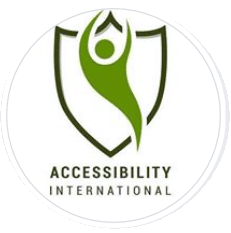Originally published in the September/October 2021 issue of the American Bankers Association Bank Compliance Magazine.
Over the past few years, a new risk and compliance concern has arisen: digital accessibility. Digital accessibility refers to the usability of digital systems—typically websites and mobile apps—for people with disabilities. In practice, most organizations think of it as “ADA for the Internet.” The Americans with Disabilities Act (ADA) requires organizations ensure “full and equal enjoyment” for people with disabilities. Since the ADA’s passage, plaintiffs’ attorneys have brought lawsuits under the ADA, asserting that defendant businesses were not in compliance with the ADA’s requirements. In the last few years, the plaintiff’s bar has expanded their ADA-related filings to include “digital systems,” resulting in an explosion of digital accessibility-related ADA filings. This article will take you through the basics of digital accessibility, help you understand the current ADA and related enforcement trends, and recommend how to get started.
What is Digital Accessibility?
Digital accessibility is broadly defined as the usability of a digital system by people with disabilities. At its simplest level, it’s ensuring that people with disabilities receive the same benefit from digital systems as people without disabilities. Ensuring digital systems are accessible requires specific programming to make certain that systems will work with the technology and techniques commonly used by people with disabilities.
As a basic example, many people who are blind use technology called a “screen reader” to interact with computers and mobile phones. This technology audibly reads the contents of the screen to the user. In the reading process, when the screen reader comes to an image, it has to make a decision about what to read to the user. The screen reader scans the coding of the page or app for something called an “alternative attribute,” which is a short piece of text that describes the image. If that alternative attribute is defined, the screen reader will be able to read it, and the user can understand the intent of the image.
In contrast, if that alternative attribute is not defined, the intent of the image is not read aloud, and the user no longer has an experience on parity with that of a sighted person. In that case, we would say the page or app is “inaccessible” and the issue at hand—not providing the “alternative attribute” for the image—is creating a barrier to using the page. Accessibility is about removing these barriers and ensuring the site or app can be fully utilized by all people.
At the highest level, an easy analogy for digital accessibility is a physical building. When you construct a building, you follow rules to ensure it is accessible for people with disabilities. You build doors of a certain width, install wheelchair ramps and elevators, allocate a certain number of parking spots, and so on. If you don’t follow those rules when you build the structure, you’re probably going to get sued. These days, if you build a site or app, you follow similar standards to ensure they are accessible for people with disabilities. If you don’t, you may be sued.
Plaintiffs’ Activity
Lawsuit filings under the ADA and related state laws have risen drastically in the last few years. A variety of organizations track filings, and while exact counts vary slightly, there is a consensus that over 250 digital accessibility cases were filed in 2016. That figure rose to over 3,500 cases filed last year. In 2021, the total number of cases is likely to exceed 5,000. (See www.adatitleiii.com/2021/04/federal-website-accessibility-lawsuits-increased-in-2020-despite-mid-year-pandemic-lull/ and www.levelaccess.com/resources/webinar-2021-digital-accessibility-trends/.)
The filing numbers, however, don’t tell the entire story. They represent only the lawsuits that are filed. For every lawsuit filed, plaintiffs’ attorneys send 6 to 7 demand letters, threatening litigation. These demand letters are growing at the same rate as is litigation.
Increased Litigation
There are an increasing number of lawsuits and demand letters because:
- The lawsuits can be highly templatized and, once the core legal arguments are created, they can be readily applied to hundreds of sites.
- Many share the core values of diversity and inclusion, and these suits can be framed as championing accessibility.
- The target of the lawsuits—websites and apps—are unlikely to be accessible “by default” and often have easy-to-find accessibility barriers.
- Finally, plaintiffs often are able to obtain quick settlements without incurring significant legal costs.
All these factors have driven growth in the “market” for lawsuits over the last few years. As a result, the number of plaintiffs’ firms filing initial suits in this space has continued to grow exponentially, and there is no indication this growth will end in the foreseeable future.
How Does the ADA Apply to Digital Systems?
Like a Facebook-era relationship status, it’s complicated. The ADA was written in 1990, before the Web came into prominence or mobile apps were even an idea, and it does not explicitly reference digital systems. Plaintiffs argue that failing to provide accessible websites or apps is a failure to eliminate barriers to access for places of public accommodation. Such access is required under Title III of the ADA which applies to most businesses.
While attempts have been made to update the ADA, they have not garnered enough support in Congress. Many jurisdictions have taken the view that the ADA applies to digital locations, however a recent decision on appeal in the Winn-Dixie case raises the possibility that a split opinion across the Federal Circuits could ultimately route the issue to the US Supreme Court for resolution.
What about the Winn-Dixie case?
The high-profile digital accessibility case that is back in recent headlines is Gil v. Winn-Dixie Stores, Inc. Originally filed in 2016, it was the first trial in the history of the ADA to squarely address whether websites are places of public accommodation under Title III. The case centered on the plaintiff’s inability to use Winn-Dixie’s website to order prescriptions, download coupons, and find store locations. The plaintiff, Juan Carlos Gil, was legally blind and used screen reader software to access websites, but Winn-Dixie’s site was incompatible with the software. Gil argued that the Winn-Dixie site violated the ADA and “had not provided full and equal enjoyment of the services, facilities, privileges, advantages and accommodations provided by and through its website.”
In a landmark decision in June 2017, Judge Robert Scola Jr. of the Southern District of Florida ruled that the grocery chain’s website had a nexus to Winn-Dixie’s physical stores and violated the ADA due to is inaccessibility. The court issued a detailed injunctive relief order which required Winn-Dixie to make its website WCAG 2.0 compliant, implement a publicly available web accessibility policy, and provide mandatory web accessibility training to its employees. It was the first decision to rule that a public accommodation violated Title III of the ADA by having an inaccessible website. Businesses facing similar complaints and trying to decide whether to settle or litigate now saw what an adverse verdict could mean.
Winn-Dixie appealed the verdict. In April 2021, after over two years of deliberation, the U.S. Court of Appeals for the 11th Circuit reversed the lower court’s determination. The court found that 1) the retailer did not violate the ADA because its website is not a place of public accommodation, and 2) the website was not shown to pose an “intangible barrier” to Gil’s access to the goods, services, privileges, or advantages of Winn Dixie’s physical stores. It is important to note that the court found that Gil had other access to the goods and services offered by Winn-Dixie because he could go into the store to refill his prescriptions and redeem coupons. It is unclear whether a different result would have been reached if the website had been Gil’s only point of access to the company’s goods and services.
Impact on Your Website
The biggest question based on that ruling is whether it will impact the increasing number of lawsuit filings. The latest ruling may have minimal impact on the overall filing trend for three key reasons:
- It is only specific to a single circuit.
- It doesn’t impact state level laws for digital accessibility.
- It doesn’t preclude other arguments for the inaccessibility of sites under the ADA—either that they block meaningful communication or that they are, in fact, intangible barriers to access (especially if the website is the only way to conduct business with the company).
The idea that an inaccessible website or app is an “intangible barrier” to the access of goods and services bears attention. The circuit court ruling pointed out that it wasn’t shown to be the case in the Winn Dixie matter, but that was a fact based ruling. In an ever increasing and integrated digital world, access to digital channels is assumed as part of the overall customer experience.
How to Comply with the ADA
When seeking to comply with the ADA, organizations can focus on two main areas: systems compliance and process compliance.
Systems Compliance
Systems compliance relates to accessibility of the digital assets that the organization makes available to the public and seeks to positively answer two questions:
- Does the site technically conform? In almost all practical situations this means: Does the site comply with the Web Content Accessibility Guidelines (WCAG)version 2.1 to the AA requirement level?
- Does the site functionally conform? Will the site actually work for a person with a disability?
The question of Technical Conformance typically looks at the conformance of the site or application with a commonly used coding standard. The de facto standard used is the WCAG. ABA counsel have observed that within these guidelines, the majority of courts that have recently required compliance with a standard have required compliance with WCAG 2.0. Similarly, a majority of plaintiffs’ demand letters have asked defendant businesses to comply with WCAG 2.0. However, the author recommends using WCAG 2.1, because it includes mobile requirements and practical use of digital systems. WCAG 2.0 also is embedded within WCAG 2.1. So, if you use WCAG 2.1, you will also be compliant with WCAG 2.0. WCAG requirements are constantly evolving, as versions 2.2 and 3.0 are already in draft form. (See www.w3.org/WAI/standards-guidelines/wcag/new-in-22/ and www.w3.org/WAI/standards-guidelines/wcag/wcag3-intro/).
The AA level—which includes the “A” level requirements as well—is broadly seen as containing all the requirements that are reasonably needed for broad access by people with disabilities. Technical Conformance is determined by automated and manual code review of the site or app against the WCAG AA requirements. It’s typically performed through a formal audit with a qualified third party and is similar in scope to an information security audit.
The question of Functional Conformance looks at the overall usability of the system for people with disabilities. If the Technical Conformance requirements are the “trees,” the Functional Conformance requirements are the forest. They look at the overall use of the system and the core concept of “full and equal enjoyment” which is a key aspect of the legal standard under the ADA commonly applied in lawsuits. Broadly, it asks the question—can a person with disabilities do the same things as a person without disabilities on the site or app? You can think of it as a very rough gauge measure of usability. It doesn’t ask “is it as efficient?” for each party—just whether there is a reasonable path for a person with disabilities to access to core features of the site or app.
Process Compliance
Process compliance means having the policies, practices, and procedures in place so accessibility compliance can be maintained on an ongoing basis. While systems compliance answers the question, “did we code this site or app properly for access?” process compliance answers the question, “will we code all future versions of the site or app properly for access?” In looking at process compliance, we broadly are assessing firms along the lines of best practices for accessibility programs. We’re seeking positive answers to questions like:
- Is there a formal testing schedule in place with a qualified third-party expert in digital accessibility?
- Is there a framework for monitoring the accessibility of the system in development and in production?
- Has appropriate training on digital accessibility requirements been deployed at relevant portions of the development lifecycle? Essentially, it’s looking at the overall processes of the organization and having confidence they will result in an accessible experience on an ongoing basis.
Implementation Roadmap
Successful organizations typically have three objectives: lawsuit avoidance, ADA compliance, and WCAG compliance.
Lawsuit Avoidance
Most organizations initially focus on avoiding lawsuits. To minimize the risk of a lawsuit, a good first step is to ensure the public facing aspects of your site or application return zero violations when checked by automated accessibility scanning tools commonly used by plaintiff attorneys. With much of the litigation that’s happening now, a lawsuit begins with a plaintiff attorney running an automated scan on a site. If that scan comes back with issues, they send a demand letter or file a lawsuit.
- Accordingly, to meet this initial objective, key activities include:
- Running a similar automated scan of the site or app to identify accessibility issues;
- Fixing the set of issues detected by the automated scan; and
- Deploying continuous automated monitoring to detect any new issues as they are introduced.
Mastering this objective deflects some risk of future lawsuits and is a robust alternative to overlays or other “separate but equal” solutions.
ADA Compliance
Compliance with the ADA’s communication provisions require organizations ensure people with disabilities can complete the core transactions of your site or app. Organizations must ensure that the activities that people do with your site or application can be done by a person with disabilities.
During this ADA Compliance phase, all issues must be fixed that cause barriers for people with disabilities. Something has to be an actual barrier for a real-world user to be a part of this phase. This contrasts with the last phase—WCAG compliance—which includes issues that may not impact the user experience but are syntactical in nature.
WCAG Compliance
The third objective aims to meet a specific industry standard—typically that means conformance with WCAG 2.0 Level AA, or preferably WCAG 2.1 Level AA requirements. While the WCAG requirements are not a legal standard they are—by far—the most widely adopted technical digital accessibility standards and are rightly considered the goal standard for accessibility. Conformance to them is generally viewed as sufficient to ensure all practical use needs of a system by people with disabilities.
As part of this phase, many organizations also seek to ensure that they have the “policies, practices, and procedures” in place to support equal access on an ongoing basis. These requirements come from the reasonable modification requirements of the ADA. They ensure that the process points discussed in the Process Compliance section of this article have been effectively implemented.
Conclusion
You’ve done the work, your website site or app is accessible, and you’ve got the systems in place to maintain it. What does that mean if you receive a threatened or actual lawsuit? It enables your organization to respond to two key plaintiff arguments:
- No barriers to the full and equal enjoyment of the site or app by people with disabilities exist. If the plaintiff alleges a specific barrier, the organization will be able to demonstrate with contemporaneous records that the barrier is not present. The organization can also demonstrate that the site or app was, in fact, tested by people with disabilities and they could use it effectively.
- Any policy, practice or procedure requested by the plaintiff—the core “injunctive relief” requested—is unnecessary. The organization already has robust policies, practices, and procedures in place to ensure accessibility issues are not introduced into the system in the future.
Being able to refute these two arguments will ensure your organization has conformed to their legal requirements under the ADA, and given themselves reasonable tools to avoid and defend against future lawsuits. Ultimately, you will be able to provide truly usable experiences to people with disabilities.




